List of Contents
Muscle Relaxant Drugs Market Size and Forecast 2025 to 2034
The global muscle relaxant drugs market size accounted for USD 4.58 billion in 2024 and is predicted to increase from USD 4.80 billion in 2025 to approximately USD 7.31 billion by 2034, expanding at a CAGR of 4.78% from 2025 to 2034. The growth of the market is driven by the increasing aging population and the rising prevalence of musculoskeletal disorders.
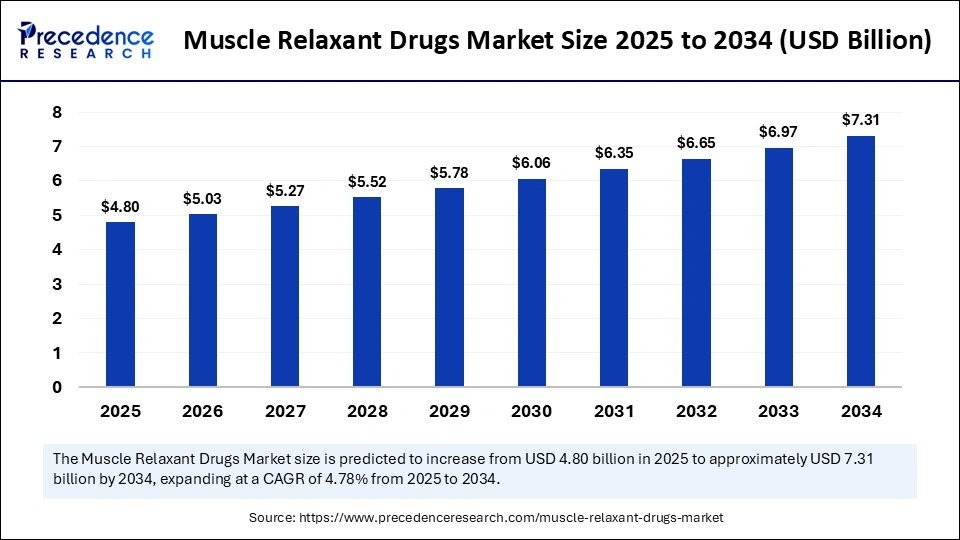
Muscle Relaxant Drugs MarketKey Takeaways
- In terms of revenue, the muscle relaxant drugs market is valued at $4.80 billion in 2025.
- It is projected to reach $7.31 billion by 2034.
- The market is expected to grow at a CAGR of 4.78% from 2025 to 2034.
- North America generated the highest revenue share of 39% in 2024.
- Asia Pacific is expected to grow at a CAGR of 5.84% between 2025 and 2034.
- By drug type, the skeletal muscle relaxant drugs segment held the major revenue share of 38% in 2024.
- By drug type, the neuromuscular blocking agents segment is growing at a CAGR of 5.1% from 2025 to 2034.
- By route of administration, the oral segment contributed the biggest revenue share of 54% in 2024.
- By route of administration, the injectables segment is projected to grow at a notable CAGR of 4.62% from 2025 to 2034.
- By distribution channel, the hospital pharmacies segment held the major revenue share of 48% in 2024.
- By distribution channel, the retail pharmacies segment is expected to grow at a significant CAGR from 2025 to 2034.
How Does AI Transforms the Muscle Relaxant Drugs Market?
Artificial intelligenceis transforming the market for muscle relaxant drugs by accelerating drug discovery, enhancing drug development processes, and personalizing treatment options. AI can identify new drug candidates, predict patient responses, and optimize drug combinations, resulting in more efficient and precise treatment strategies. Furthermore, AI can optimize drug synthesis, predict drug interactions, and identify potential side effects, assisting pharmaceutical companies in developing more effective and safer muscle relaxant drugs and customizing muscle relaxant dosages and combinations to meet individual patient needs and characteristics. AI helps in the development of personalized drugs by analyzing huge amounts of patient data.
U.S. Muscle Relaxant Drugs Market Size and Growth 2025 to 2034
The U.S. muscle relaxant drugs market size was exhibited at USD 1.55 billion in 2024 and is projected to be worth around USD 2.53 billion by 2034, growing at a CAGR of 5.02% from 2025 to 2034.
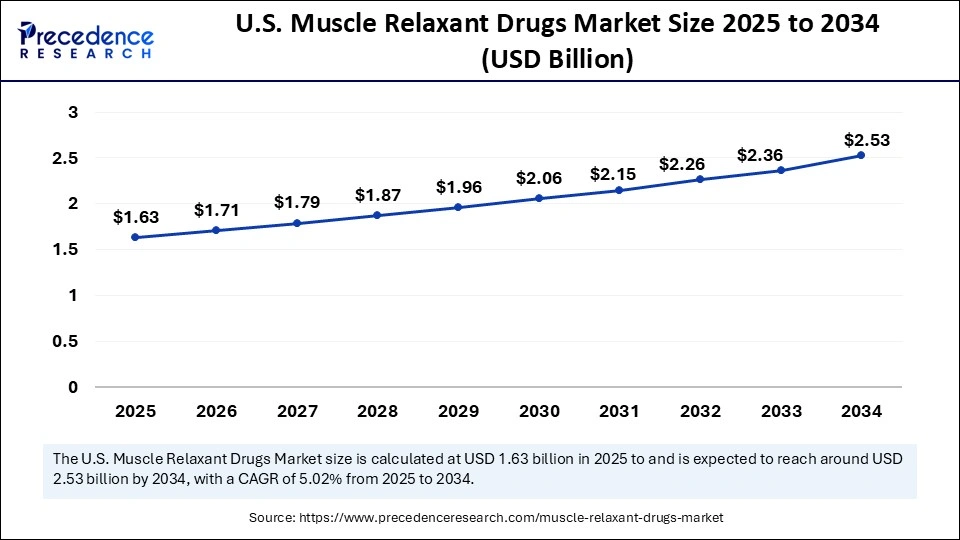
What Made North America the Dominant Region in 2024?
North America dominated the muscle relaxant drugs market by capturing the largest revenue share of 39% in 2024, driven by a well-established healthcare infrastructure that enables access to advanced treatments and therapies, including muscle relaxants, along with a vast aging population and the increased prevalence of musculoskeletal disorders. The region's dominance is further reinforced by significant healthcare expenditure and government initiatives, along with fundings that actively promote pharmaceutical research and development, fostering innovation in the muscle relaxant drug sector. North America boasts a thriving pharmaceutical industry with leading companies engaged in developing new muscle relaxants.
The U.S Muscle Relaxant Drugs Market Trends
The U.S. plays a major role in the North American muscle relaxant drugs market. The growth of the market in the U.S. is driven by its advanced healthcare infrastructure, high healthcare spending, and a large population experiencing musculoskeletal disorders. Additionally, the pharmaceutical industry in the U.S. is actively engaged in researching and developing new muscle relaxant drugs. There is a high prevalence of arthritis, supporting market growth. Arthritis is a common condition, with 1 in 5 U.S. adults reporting a diagnosis.
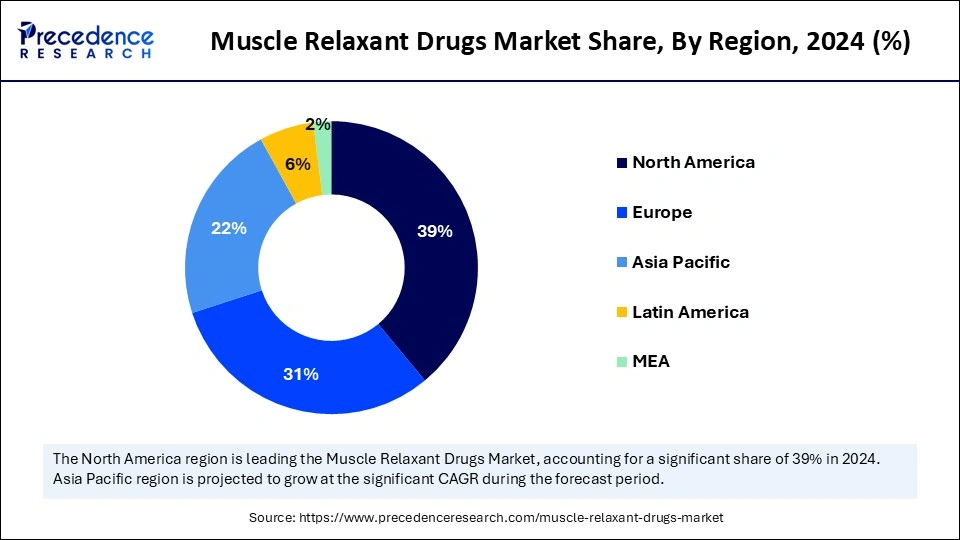
What Factors Contribute to the Muscle Relaxant Drugs Market Within Asia Pacific?
Asia Pacific is growing at a compounding annual growth rate (CAGR) of 5.84% during the predicted timeframe, owing to increasing urbanization, a strong pharmaceutical base, rising disposable incomes, and a growing geriatric population, which contributes to a surge in demand for muscle relaxants. Furthermore, economies in the region are growing rapidly, particularly in countries like China and India, leading to greater willingness and ability to afford healthcare, including muscle relaxants. Moreover, advancements in healthcare infrastructure, increased government investments in research and development, and strategic collaborations between key market players are driving market expansion in the region. The rapid expansion of online pharmacies is improving accessibility to muscle relaxant drugs.
China Muscle Relaxant Drugs Market Trends
China is emerging as a significant player in the global market. This is due to the rising number of clinical trials, indicating a growing research and development sector within the country. China is making significant investments in biotechnology, leading to the discovery and production of novel muscle relaxant drugs. Moreover, the Chinese government is focusing on boosting its local production capacity to meet domestic demand and support exports.
India Muscle Relaxant Drugs Market Trends
India is also a significant contributor to the market, experiencing rapid growth due to increasing domestic production of drugs. As a major producer of generic drugs, including muscle relaxants, India is actively enhancing its production capabilities. Additionally, India is focusing on domestic acquisitions, such as the CORONA Remedie acquisition of Myoril from Sanofi, and expanding its generic manufacturing capabilities, reflecting a strategic approach to strengthening its position in the global market.
What Opportunities Exist in the Muscle Relaxant Drugs Market Within Europe?
Europe is considered to be a significantly growing area. The growth of the market in the region is primarily driven by an aging population, the rising prevalence of musculoskeletal disorders, and a well-established healthcare system. Many countries, including Germany and the UK, have robust healthcare systems and favorable reimbursement policies, which support the use of muscle relaxant drugs and other pain therapies. Furthermore, the presence of some leading players like Pfizer, Teva Pharmaceutical Industries, Ipsen Pharma, and Amneal Pharmaceuticals bolsters market growth.
Market Overview
Muscle relaxant drugs involve medications indicated for reducing muscle tone, alleviating muscle spasms, and managing pain associated with musculoskeletal conditions, which are broadly categorized into centrally acting and peripherally acting relaxants. The muscle relaxant drugs market is witnessing rapid growth due to the growing demand for effective pain management and the expansion of healthcare infrastructure in emerging economies, driven by the increasing prevalence of musculoskeletal conditions and the rising number of sports-related injuries. Sports injuries can result in pain, muscle spasm, and decreased mobility, making muscle relaxants essential for managing pain and enhancing quality of life. In addition, the growing geriatric population across the globe is expected to boost the growth of the market in the coming years. Musculoskeletal conditions like back pain and muscle spasm are prevalent among older adults, creating the need for effective pain management therapies.
What Are the Key Trends in the Muscle Relaxant Drugs Market?
- Effective Pain Management Solutions: The demand for effective pain management solutions for various conditions, including postoperative pain, with increasing preference for non-opioid pain relief options, including muscle relaxants, fosters market growth.
- Growing Aging Population: The growing elderly population is more prone to musculoskeletal problems and may require muscle relaxants for pain management and improved mobility, resulting in increased demand for muscle relaxants.
- Rising Cases of Sports-Related Injuries: Sports-related injuries like sprains and strains often lead to muscle spasms and pain, as well as accidents, including those from road traffic accidents, which also necessitate the use of muscle relaxants.
- Advancements in Drug Formulations: Improvements in drug formulations and the development of new therapeutics, including the development of longer-acting and less sedating options, are also expected to drive market growth.
Market Scope
| Report Coverage | Details |
| Market Size by 2034 | USD 7.31 Billion |
| Market Size in 2025 | USD 4.80 Billion |
| Market Size in 2024 | USD 4.58 Billion |
| Market Growth Rate from 2025 to 2034 | CAGR of 4.78% |
| Dominating Region | North America |
| Fastest Growing Region | Asia Pacific |
| Base Year | 2024 |
| Forecast Period | 2025 to 2034 |
| Segments Covered | Drug type, Route of Administration, Distribution Channel, and Region |
| Regions Covered | North America, Europe, Asia-Pacific, Latin America, and Middle East & Africa |
Market Dynamics
Drivers
Rising Incidence of Musculoskeletal Disorders
The primary driver in the muscle relaxant drugs market is the rising incidence of musculoskeletal disorders, including muscle spasms, spasticity, and pain. As the aging population grows, there is a higher prevalence of musculoskeletal issues, which can be worsened by related conditions like multiple sclerosis. The prevalence of conditions like arthritis, fibromyalgia, and back and neck pain is also rising. According to a report, about 1 billion people worldwide will have osteoarthritis by 2050. This, in turn, drives the necessity for effective muscle relaxant drugs for pain management therapies. In addition to this, the rising number of cases of sports injuries boosts the demand for muscle relaxants to help manage pain and support recovery.
Restraint
Potential for Significant Side Effects
The primary restraint in the muscle relaxant drug market is the potential for significant side effects. These can include dizziness, drowsiness, and impaired coordination, raising safety concerns, especially for individuals who operate machinery or engage in activities requiring alertness. While muscle relaxants are beneficial for managing muscle spasms and pain, they can also cause a range of adverse effects, which can discourage patients from using these medications. Moreover, the availability of alternative therapies like physiotherapy and rising product recalls hamper the growth of the market.
- In March 2022, Sandoz recalled 13 lots of oral orphenadrine citrate 100 mg extended-release tablets to the consumer level, which are classified as skeletal muscle relaxants. The presence of nitrosamine above acceptable limits was detected in the lots during recent testing, which could lead to cancer. Sandoz has not received any reports of adverse events.
(Source: https://www.managedhealthcareexecutive.com)
Opportunity
Development of Novel Formulations and Innovative Drug Delivery Systems
The key future opportunity in the muscle relaxant drugs market lies in the development of novel formulations and innovative drug delivery systems. This includes both new drug molecules and improved methods of administering existing drugs to enhance efficacy and patient compliance and target specific patient populations. Developing novel drug molecules with enhanced properties, such as extended-release formulations or targeted delivery systems, alongside advanced delivery methods like oral granules, injectable formulations, or tramadol patches, leads to better patient outcomes. Moreover, the rising demand for targeted and personalized drugs is expected to fuel the growth of the market during the forecast period.
Drug Type Insights
Which Drug Type Dominated the Muscle Relaxant Drugs Market In 2024?
The skeletal muscle relaxant drugs segment dominated the market with the largest revenue share of 38% in 2024. This is mainly due to their wide application in treating various muscle-related conditions, from muscle spasms to back pain. Skeletal muscle relaxant drugs are prescribed for both acute and chronic pain management. This segment's dominance is further attributed to improvements in drug formulations, such as extended-release or targeted delivery systems, which enhance effectiveness and reduce side effects.
The neuromuscular blocking agents segment is expected to grow at a CAGR of 5.1% during the forecast period. This is mainly due to their essential role in surgical procedures, critical care, and endotracheal intubation. The need for these agents is fueled by increasing surgical volumes, a growing aging population requiring more critical care, and the demand for efficient muscle relaxation during procedures. Overall, neuromuscular blocking agents are crucial for facilitating muscle relaxation during surgery, allowing surgeons to perform procedures with greater ease and precision while minimizing risks and improving patient outcomes.
Route of Administration Insights
How Does Oral Segment Dominate the Muscle Relaxant Drugs Market in 2024?
The oral segment dominated the market with the highest revenue share of 54% in 2024, driven by its non-invasive nature, which makes it more comfortable and preferred by patients, especially geriatric ones who often face difficulty in swallowing. The ease of administration and high patient compliance with oral formulations make them highly preferable. Oral medications also provide a convenient and accessible treatment option for conditions like back pain and muscle spasms, eliminating the need for injections and other invasive procedures. Consequently, the market features a wide array of oral formulations, including tablets, capsules, and suspensions, catering to different patient demands and preferences. This convenience translates to better patient adherence to treatment regimens and overall satisfaction.
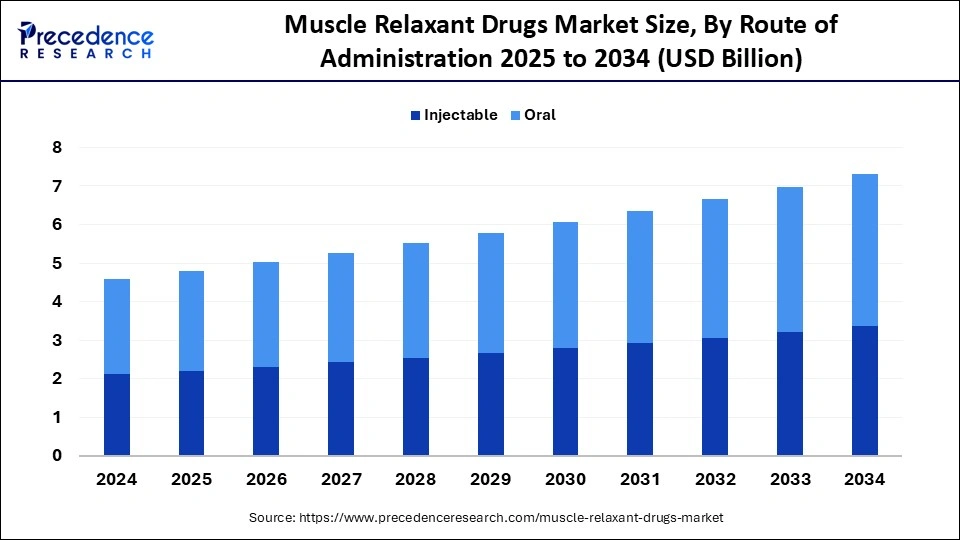
The injectables segment is expanding at a CAGR of 4.62% during the projection period. The growth of the segment is attributed to the increasing demand for rapid relief and precise control over muscle relaxation, particularly in surgical settings and for conditions requiring a quick onset of action. Injectable formulations also enable targeted delivery of muscle relaxants to specific muscle groups, reducing systemic effects and enhancing therapeutic efficacy. Ongoing research and development efforts are focused on creating new injectable muscle relaxants with improved efficacy, safety profiles, and longer-lasting effects.
Distribution Channel Insights
Why did Hospital Pharmacies Segment Dominate the Market in 2024?
The hospital pharmacies segment dominated the muscle relaxant drugs market with a major revenue share of 48% in 2024, driven by the increased clinical and hospital visits, the increasing geriatric population, and the demand for centralized procurement and distribution of medications. The demand for muscle relaxants is particularly elevated within hospitals, as they are utilized for various conditions and procedures. These pharmacies are staffed by pharmacists with specialized knowledge and the capability to dispense these medications under the guidance of healthcare professionals, ensuring timely availability. Moreover, the increased number of surgical procedures performed in hospitals further creates the need for muscle relaxant drugs, contributing to segmental growth.
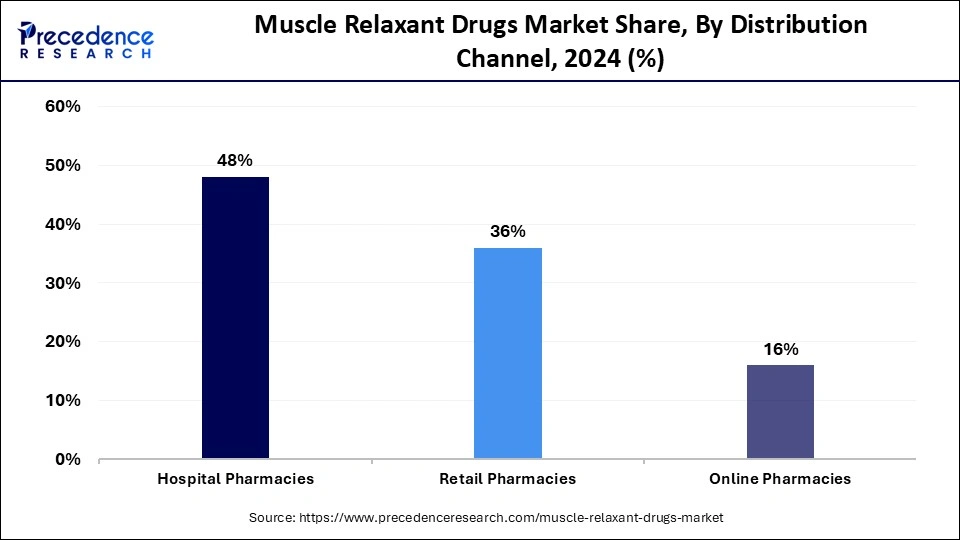
The retail pharmacies segment is expected to grow at a significant rate over the projected period. Retail pharmacies offer a broader range of services and cater to the needs of diverse patient populations, including those with chronic conditions and those who prefer to purchase their medications directly from a pharmacy. The increasing prevalence of muscle-related conditions, an aging population, and a growing preference for convenient access to medications further support this segment's growth. Moreover, the growing trend of patients purchasing medications directly from pharmacies contributes to segmental growth.
Muscle Relaxant Drugs Market Companies
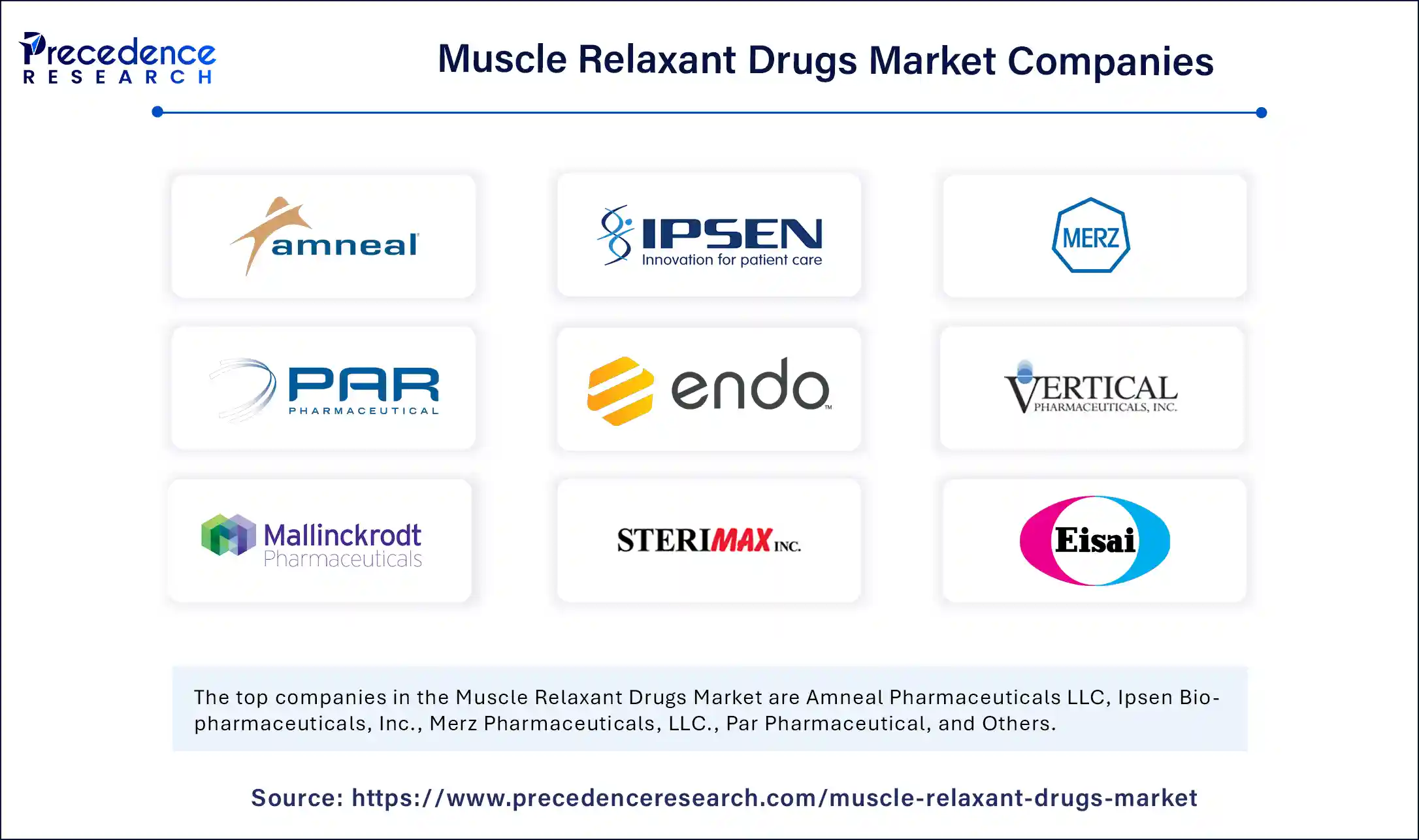
- Amneal Pharmaceuticals LLC
- Ipsen Biopharmaceuticals, Inc.
- Merz Pharmaceuticals, LLC.
- Par Pharmaceutical
- Endo Pharmaceuticals
- Vertical Pharmaceuticals
- Mallinckrodt
- SteriMax
- Eisai Co., Ltd.
- Metacel Pharmaceuticals, LLC.
- Teva Pharmaceuticals USA, Inc.
Recent Developments
- In March 2024, Nexus Pharmaceuticals launched Baclofen Injection, USP. This sterile solution is designed for intrathecal administration and acts as a muscle relaxant and antispastic. Baclofen Injection is often used to treat patients with multiple sclerosis, cerebral palsy, spinal cord injuries, and other conditions that cause muscle spasms, thus providing essential pharmaceuticals that make a real difference in people's lives.
(Source: https://www.businesswire.com) - In November 2023, Lupin launched Rocuronium Bromide Injection, 10 mg/mL, and 10 mg/mL Multiple-Dose Vials, following the approval for its ANDA from the U.S. FDA granted to Lupin's alliance partner Caplin. This product is indicated for inpatients and outpatients as an adjunct to general anesthesia to facilitate both rapid sequence and routine tracheal intubation, providing skeletal muscle relaxation during surgery or mechanical ventilation.
(Source: https://www.lupin.com) - In June 2023, CORONA Remedies announced its acquisition of the Myoril brand from pharmaceutical giant Sanofi Healthcare India. Valued at ₹234 crore, this acquisition positions CORONA as a player in the muscle relaxant segment, adding the established and trusted Myoril brand to its portfolio by leveraging its sales team and distribution network.
(Source: https://www.healthcareradius.in)
Segments Covered in the Report
By Drug type
- Skeletal Muscle Relaxant Drugs
- Facial Muscle Relaxant Drugs
- Neuromuscular Blocking Agents
By Route of Administration
- Oral
- Injectable
By Distribution Channel
- Hospital Pharmacies
- Retail Pharmacies
- Online Pharmacies
By Region
- North America
- Europe
- Asia Pacific
- Latin America
- Middle East and Africa
For inquiries regarding discounts, bulk purchases, or customization requests, please contact us at sales@precedenceresearch.com
Frequently Asked Questions
Ask For Sample
No cookie-cutter, only authentic analysis – take the 1st step to become a Precedence Research client